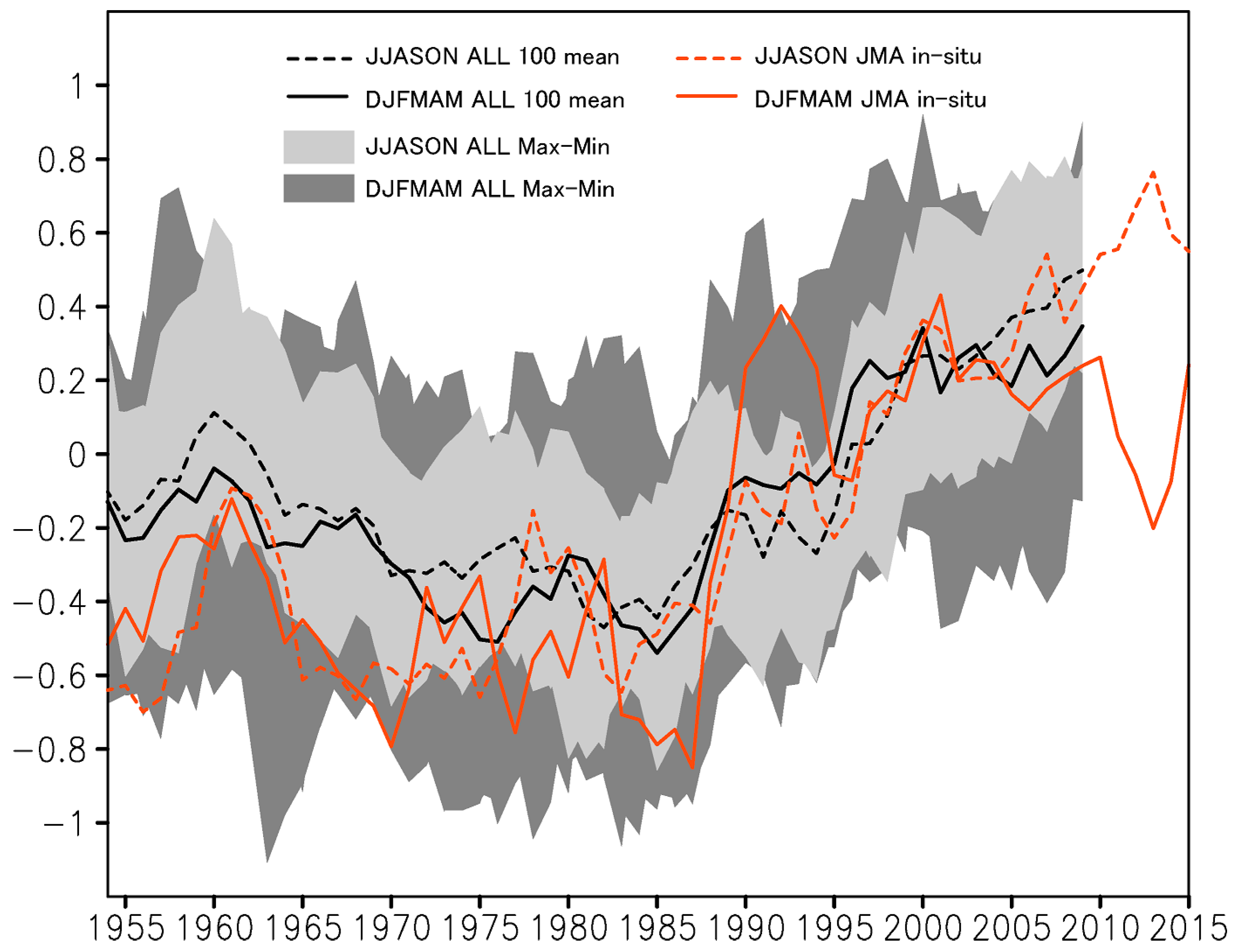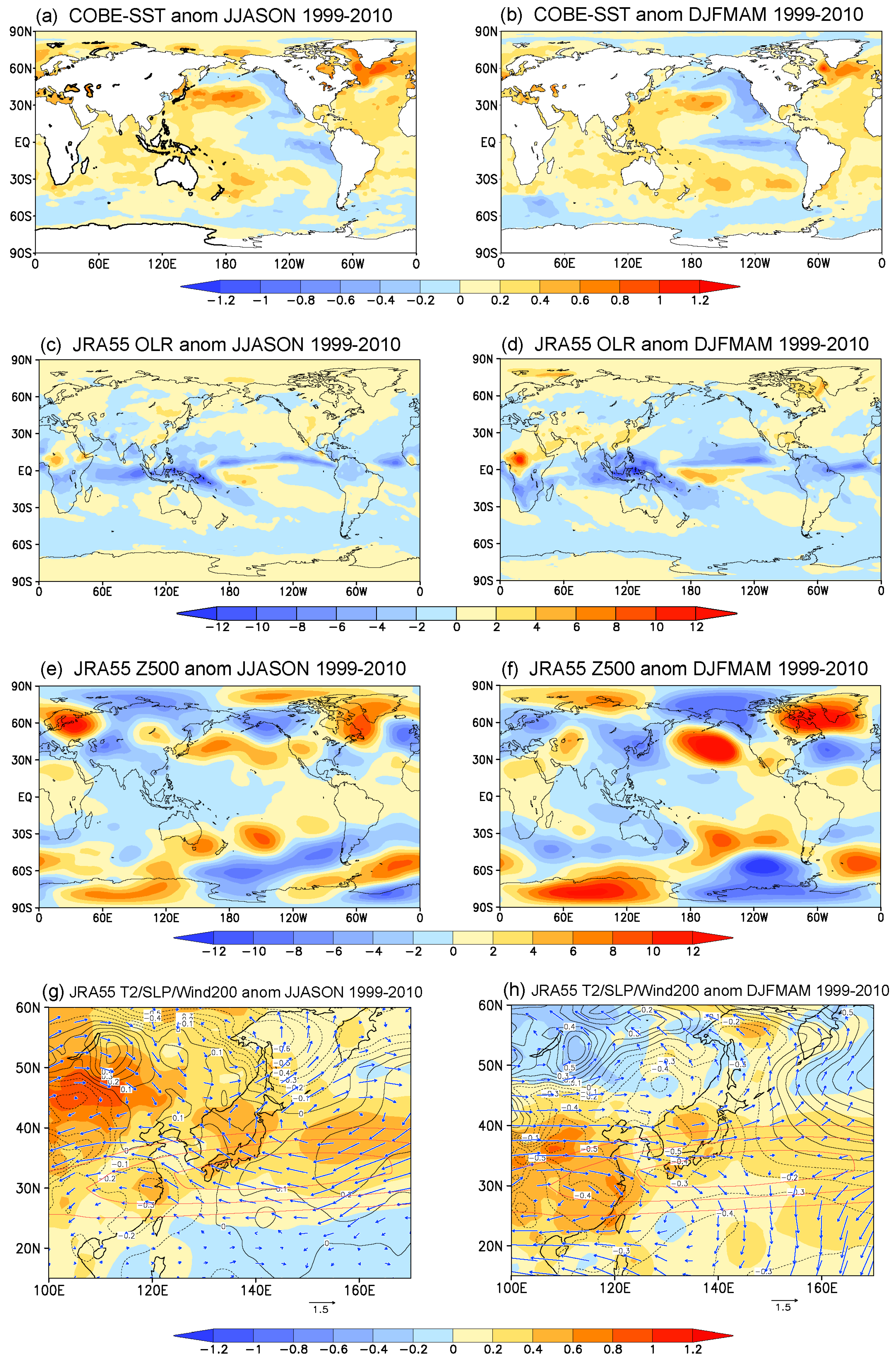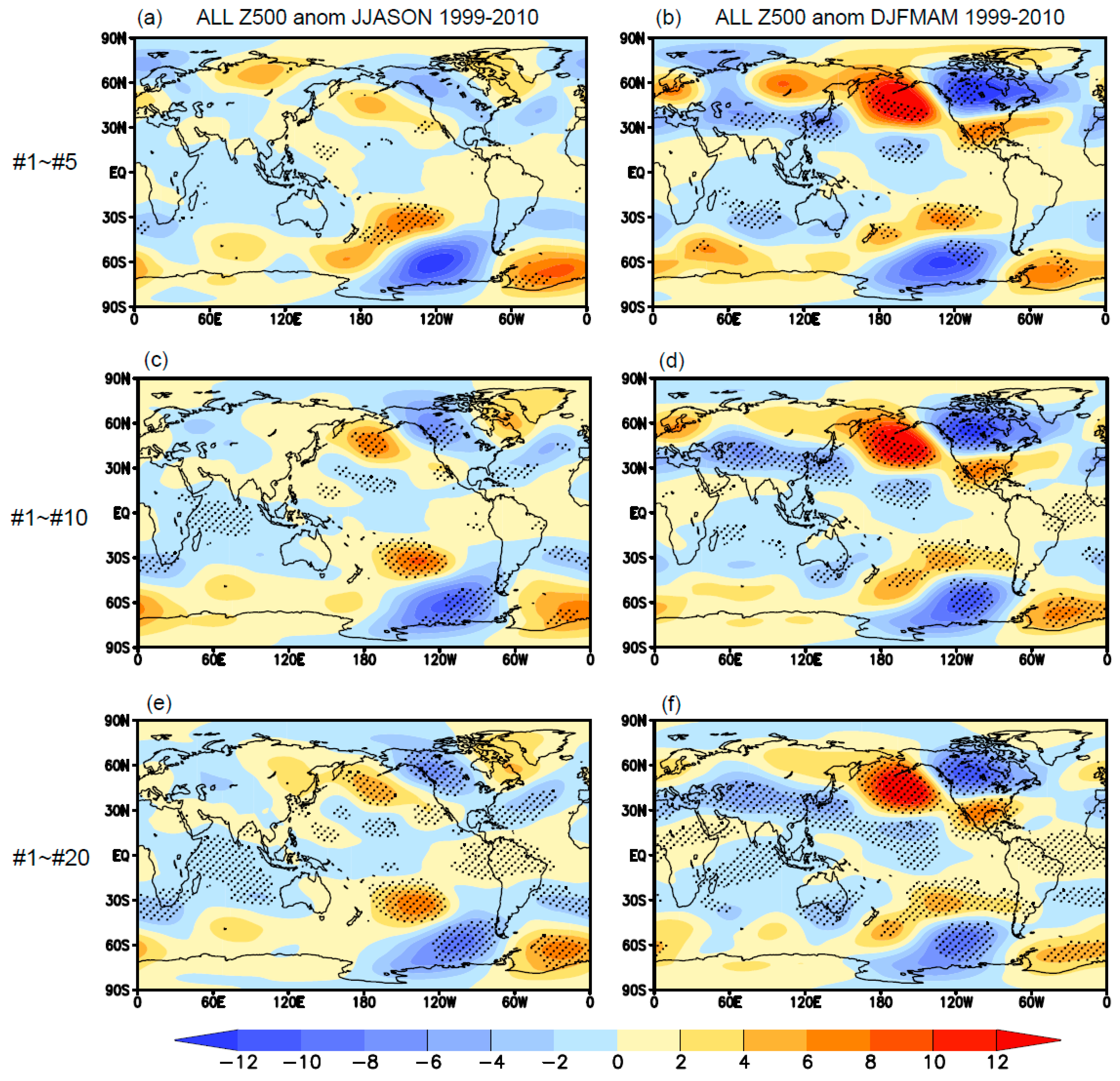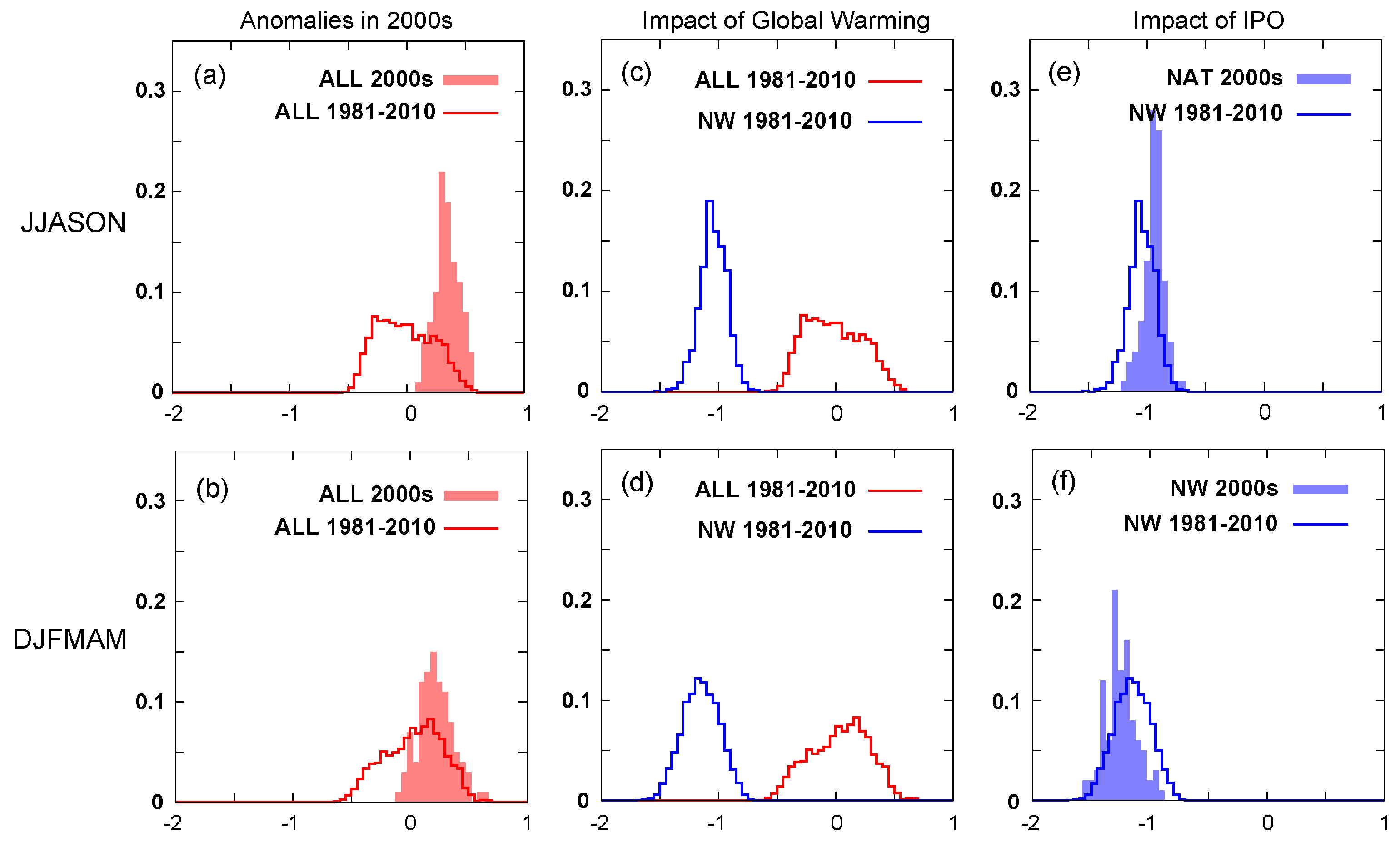Recent Enhanced Seasonal Temperature Contrast in Japan from Large Ensemble High-Resolution Climate Simulations
Abstract
:1. Introduction
2. Methodology
2.1. Model
2.2. Experimental Design
3. Results
3.1. Historical Changes in the Surface Temperature of Japan
3.2. Atmospheric Anomalies in the 2000s
3.3. Attribution Study
4. Conclusions
Acknowledgments
Author Contributions
Conflicts of Interest
References
- Urabe, Y.; Maeda, S. The relationship between Japan’s recent temperature and decadal variability. SOLA 2014, 10, 176–179. [Google Scholar] [CrossRef]
- Zhang, Y.; Wallace, J.M.; Battisti, D.S. ENSO-like interdecadal variability. J. Clim. 1997, 10, 1004–1020. [Google Scholar] [CrossRef]
- Power, S.; Casey, C.; Folland, C.; Colman, A.; Mehta, V. Inter-decadal modulation of the impact of ENSO on Australia. Clim. Dyn. 1999, 15, 319–324. [Google Scholar] [CrossRef]
- Meehl, G.A.; Arblaster, J.M.; Fasullo, J.T.; Hu, J.; Trenberth, K.E. Model-based evidence of deep-ocean heat uptake during surface-temperature hiatus periods. Nat. Clim. Chang. 2011, 1, 360–364. [Google Scholar] [CrossRef]
- Meehl, G.A.; Hu, A.; Arblaster, J.M.; Fasullo, J.; Trenberth, K.E. Externally forced and internally generated decadal climate vaeiability associated with the Interdecadal Pacific Oscillation. J. Clim. 2013, 26, 7298–7310. [Google Scholar] [CrossRef]
- Kosaka, Y.; Xie, S.P. Recent global-warming hiatus tied to equatorial Pacific surface cooling. Nature 2013, 501, 403–407. [Google Scholar] [CrossRef] [PubMed]
- Watanabe, M.; Kamae, Y.; Yoshimori, M.; Oka, A.; Sato, M.; Ishii, M.; Mochizuki, T.; Kimoto, M. Strengthening of ocean heat uptake efficiency associated with the recent climate hiatus. Geophys. Res. Lett. 2013, 40. [Google Scholar] [CrossRef]
- Japan Meteorological Agency. El Nino and Japanese Climate. Available online: http://www.data.jma.go.jp/gmd/cpd/data/elnino/learning/tenkou/nihon1.html (accessed on 30 December 2016).
- Maeda, S. ENSO and Japan’s climate. Meteorol. Res. Note 2014, 228, 167–179. (In Japanese) [Google Scholar]
- Wu, L.; Cai, W.; Zhang, L.; Nakamura, H.; Timmermann, A.; Joyce, T.; McPhaden, M.J.; Alexander, M.; Qiu, B.; Visbeck, M.; et al. Enhanced warming over the global subtropical western boundary currents. Nat. Clim. Chang. 2012, 2, 161–166. [Google Scholar] [CrossRef] [Green Version]
- Xie, S.-P.; Hu, K.; Hafner, J.; Tokinaga, H.; Du, Y.; Huang, G.; Sampe, T. Indian Ocean capacitor effect on Indo-western Pacific climate during the summer following El Nino. J. Clim. 2009, 22, 730–747. [Google Scholar] [CrossRef]
- Imada, Y.; Shiogama, H.; Watanabe, M.; Mori, M.; Ishii, M.; Kimoto, M. The contribution of anthropogenic forcing to the Japanese heat waves of 2013. In “Explaining Extreme Events of 2013 from a Climate Perspective”. Bull. Am. Meteorol. Soc. 2014, 95, S52–S54. [Google Scholar]
- Deser, C.; Phillips, A.S.; Alexander, M.A. Twentieth century tropical sea surface temperature trends revisited. Geophys. Res. Lett. 2010, 37, L10701. [Google Scholar] [CrossRef]
- Tokinaga, H.; Xie, S.-P.; Deser, C.; Kosaka, Y.; Okumura, Y.M. Slowdown of the Walker circulation driven by tropical Indo-Pacific warming. Nature 2012, 491, 439–443. [Google Scholar] [CrossRef] [PubMed]
- Christidis, N.; Stott, P.A. Change in the odds of warm years and seasons due to anthropogenic influence on the climate. J. Clim. 2014, 27, 2607–2621. [Google Scholar] [CrossRef]
- Hirahara, S.; Ohno, H.; Oikawa, Y.; Maeda, S. Strengthening of the southern side of the jet stream and delayed withdrawal of Baiu season in future climate. J. Meteorol. Soc. Jpn. 2012, 90, 663–671. [Google Scholar] [CrossRef]
- Lu, J.; Vecchi, G.A.; Reichler, T. Expansion of the Hadley cell under global warming. Geophys. Res. Lett. 2007, 34, L06805. [Google Scholar]
- Deser, C.; Phillips, A.; Bourdette, V.; Teng, H. Uncertainty in climate change projections: The role of internal variability. Clim. Dyn. 2012, 38, 527–546. [Google Scholar] [CrossRef]
- Mizuta, R.; Murata, A.; Ishii, M.; Shiogama, H.; Hibino, K.; Mori, N.; Arakawa, O.; Imada, Y.; Yoshida, K.; Aoyagi, T.; et al. Over 5000 years of ensemble future climate simulations by 60 km global and 20 km regional atmospheric models. Bull. Am. Meteorol. Soc. 2016. [Google Scholar] [CrossRef]
- Data Integration and Analysis System Program. Available online: http://www.diasjp.net/en/ (accessed on 17 March 2017).
- Imada, Y.; Shiogama, H.; Watanabe, M.; Mori, M.; Ishii, M.; Kimoto, M. Contribution of anthropogenic circulation change to the 2012 heavy rainfall in southern Japan. In “Explaining Extreme Events of 2012 from a Climate Perspective”. Bull. Am. Meteorol. Soc. 2013, 94, S52–S54. [Google Scholar]
- Outline NWP March. 2007. Available online: http://www.jma.go.jp/jma/jma-eng/jma-center/nwp/outline-nwp/index.htm (accessed on 30 December 2016).
- Mizuta, R.; Yoshimura, H.; Murakami, H.; Matsueda, M.; Endo, H.; Ose, T.; Kamiguchi, K.; Hosaka, M.; Sugi, M.; Yukimoto, S.; et al. Climate simulations using MRI-AGCM3.2 with 20-km grid. J. Meteorol. Soc. Jpn. 2012, 90A, 233–258. [Google Scholar] [CrossRef]
- Hirahara, S.; Ishii, M.; Fukuda, Y. Centennial-scale sea surface temperature analysis and its uncertainty. J. Clim. 2014, 27, 57–75. [Google Scholar] [CrossRef]
- Shiogama, H.; Imada, Y.; Mori, M.; Mizuta, R.; Stone, D.; Yoshida, K.; Arakawa, O.; Ikeda, M.; Takahashi, C.; Arai, M.; et al. Attributing historical changes in probabilities of record-breaking daily temperature and precipitation extreme events. SOLA 2016, 12, 225–231. [Google Scholar] [CrossRef]
- Kobayashi, S.; Yukinari, O.; Yayoi, H.; Ebita, A.; Moriya, M.; Onoda, H.; Onogi, K.; Kamahori, H.; Kobayashi, C.; Endo, H.; et al. The JRA-55 reanalysis: General specifications and basic characteristics. J. Meteorol. Soc. Jpn. 2015, 93, 5–48. [Google Scholar] [CrossRef]
- Japan Meteorological Agency. Monthly Temperature Anomaly in Japan. Available online: http://www.data.jma.go.jp/cpdinfo/temp/list/csv/mon_jpn.csv (accessed on 13 February 2017).








© 2017 by the authors. Licensee MDPI, Basel, Switzerland. This article is an open access article distributed under the terms and conditions of the Creative Commons Attribution (CC BY) license ( http://creativecommons.org/licenses/by/4.0/).
Share and Cite
Imada, Y.; Maeda, S.; Watanabe, M.; Shiogama, H.; Mizuta, R.; Ishii, M.; Kimoto, M. Recent Enhanced Seasonal Temperature Contrast in Japan from Large Ensemble High-Resolution Climate Simulations. Atmosphere 2017, 8, 57. https://doi.org/10.3390/atmos8030057
Imada Y, Maeda S, Watanabe M, Shiogama H, Mizuta R, Ishii M, Kimoto M. Recent Enhanced Seasonal Temperature Contrast in Japan from Large Ensemble High-Resolution Climate Simulations. Atmosphere. 2017; 8(3):57. https://doi.org/10.3390/atmos8030057
Chicago/Turabian StyleImada, Yukiko, Shuhei Maeda, Masahiro Watanabe, Hideo Shiogama, Ryo Mizuta, Masayoshi Ishii, and Masahide Kimoto. 2017. "Recent Enhanced Seasonal Temperature Contrast in Japan from Large Ensemble High-Resolution Climate Simulations" Atmosphere 8, no. 3: 57. https://doi.org/10.3390/atmos8030057




